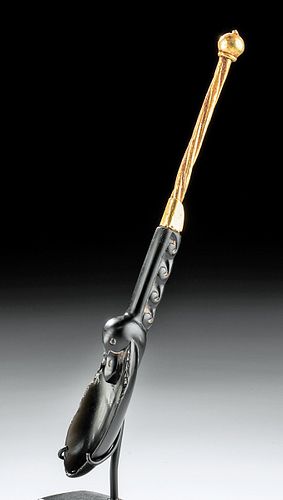Phoenician Obsidian Spoon w / 20K+ Gold Handle
Lot 65e
About Seller
Artemis Gallery
686 S Taylor Ave, Ste 106
Louisville, CO 80027
United States
Selling antiquities, ancient and ethnographic art online since 1993, Artemis Gallery specializes in Classical Antiquities (Egyptian, Greek, Roman, Near Eastern), Asian, Pre-Columbian, African / Tribal / Oceanographic art. Our extensive inventory includes pottery, stone, metal, wood, glass and textil...Read more
Categories
Estimate:
$16,000 - $24,000
Absentee vs Live bid
Two ways to bid:
- Leave a max absentee bid and the platform will bid on your behalf up to your maximum bid during the live auction.
- Bid live during the auction and your bids will be submitted real-time to the auctioneer.
Bid Increments
| Price | Bid Increment |
|---|---|
| $0 | $25 |
| $300 | $50 |
| $1,000 | $100 |
| $2,000 | $250 |
| $5,000 | $500 |
| $10,000 | $1,000 |
| $20,000 | $2,500 |
| $50,000 | $5,000 |
| $100,000 | $10,000 |
| $200,000 | $20,000 |
About Auction
By Artemis Gallery
Feb 13, 2020
Set Reminder
2020-02-13 10:00:00
2020-02-13 10:00:00
America/New_York
Bidsquare
Bidsquare : Exceptional Antiquities, Asian, Ethnographic
https://www.bidsquare.com/auctions/artemis-gallery/exceptional-antiquities-asian-ethnographic-4848
An important one-day auction featuring museum-worthy examples of Egyptian, Greek, Roman, Etruscan, Near Eastern, Far East / Asian, Pre-Columbian, African / Tribal, Oceanic, Native American, Spanish Colonial, Russian, Fossils, Ancient Jewelry, Fine Art, so much more! Artemis Gallery info@artemisgallery.com
An important one-day auction featuring museum-worthy examples of Egyptian, Greek, Roman, Etruscan, Near Eastern, Far East / Asian, Pre-Columbian, African / Tribal, Oceanic, Native American, Spanish Colonial, Russian, Fossils, Ancient Jewelry, Fine Art, so much more! Artemis Gallery info@artemisgallery.com
- Lot Description
Ancient Eastern Mediterranean, Phoenicia, ca. 6th to 4th century BCE. Wow! An incredible spoon, with a twisted 20K+ gold handle (equivalent to 20K+) and carved obsidian lower body and bowl. The golden handle features a large bauble at the top and a socket at its base that fits neatly into a tab on the obsidian lower body. Below this tab, the obsidian has a thick, stem-like portion that serves as the lower part of the handle and is incised with repeated wave motif imagery. The elongated bowl features a high relief swan or duck head at its upper end, as if the animal is dipping its beak to skim along the surface of whatever liquid is in the spoon. The animal has charming incised eyes, nostrils, and beak outline. The style of the animal is inspired by Near Eastern artwork which the Phoenicians, as a great maritime culture, would have been familiar with from trade. Size: 0.9" W x 7.55" H (2.3 cm x 19.2 cm); 7.5" H (19 cm) on included custom stand; gold quality: 84%, equivalent to 20K+
Gold and obsidian are materials found in the royal tombs excavated from ancient Phoenicia, suggesting that this spoon was made for someone of very elite status indeed - or possibly their child! Interestingly, the duck or swan image was found on the prows of Greek and Aegean ships, so this may have belonged to someone with ties to trade with those regions.
Bronze ladles of similar style to this spoon with the swan's head manufactured in Phoenicia and traded to Cyprus have been found in a variety of tombs, such as British Tomb 84 at Amathus and the Western Acropolis of Idalion.
Provenance: ex-Neil Phillips collection, New York, USA, acquired in the 1980s
All items legal to buy/sell under U.S. Statute covering cultural patrimony Code 2600, CHAPTER 14, and are guaranteed to be as described or your money back.
A Certificate of Authenticity will accompany all winning bids.
We ship worldwide and handle all shipping in-house for your convenience.
#152860The handle separates easily from the lower part of the spoon. Handle has slight bending to form with rich deposits but is overall beautifully preserved. The lower body has some small chips around the peripheries but is also in overall lovely condition.Condition
- Shipping Info
-
All shipping is handled in-house for your convenience. Your invoice from Artemis Gallery will include shipping calculation instructions. If in doubt, please inquire BEFORE bidding for estimated shipping costs for individual items.
-
- Buyer's Premium



 EUR
EUR CAD
CAD AUD
AUD GBP
GBP MXN
MXN HKD
HKD CNY
CNY MYR
MYR SEK
SEK SGD
SGD CHF
CHF THB
THB














